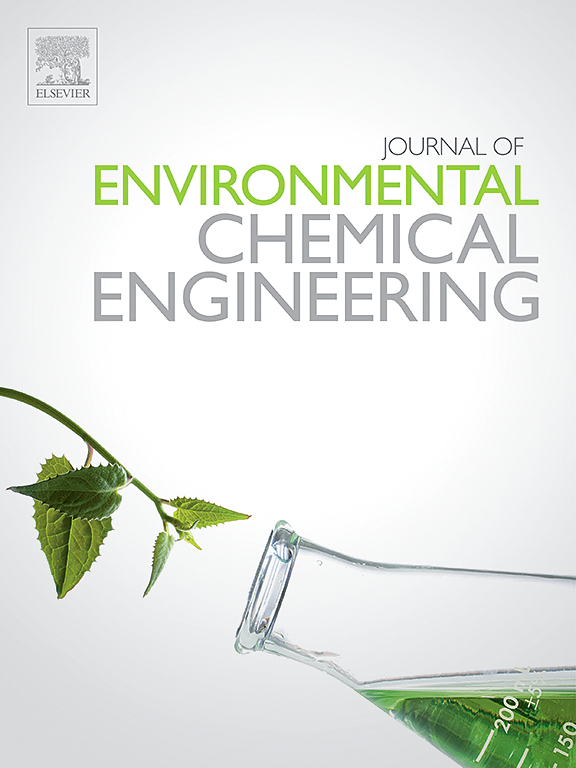揭示二氧化硫和多氯二苯并对二恶英/多氯二苯并呋喃在活性炭吸附上的竞争机制
IF 7.4
2区 工程技术
Q1 ENGINEERING, CHEMICAL
引用次数: 0
摘要
在城市固体废物焚烧(MSWI)厂中,活性炭(AC)吸附是消除烟气中多氯二苯并对二恶英和多氯二苯并呋喃(PCDD/Fs)的关键技术。这项研究深入探讨了二氧化硫和多氯二苯并对二恶英和多氯二苯并呋喃(PCDD/Fs)之间潜在的竞争性吸附,并研究了 AC 层中心和边缘的吸附如何影响吸附过程。研究结果表明,使用经二氧化硫预处理(AC-A3)和 H2SO4 浸渍(AC-B2)的活性炭时,多氯二苯并对二恶英和多氯二苯并呋喃的去除率分别从 86.8% 下降到 84.2%,再进一步下降到 74.4%。多种表征方法表明,硫元素占据了活性炭内孔的活性位点,降低了其孔隙结构的可用性,尤其是对微孔结构的影响大于中孔结构。DFT 计算表明,π-π EDA 效应促进了 2,3,7,8-四氯二苯并对二恶英(2,3,7,8-TCDD)的吸附,而分散力则推动了二氧化硫的吸附。对各种含氧官能团的比较表明,有机酸酐(CO-CO)对 TCDD 具有更好的吸附选择性,而对 SO2 的吸附能力较弱。这项研究为多氯二苯并对二恶英和多氯二苯并呋喃在 AC 上的吸附机制以及烟气中硫的竞争动态提供了一个新的视角。本文章由计算机程序翻译,如有差异,请以英文原文为准。
Unveiling the competitive mechanism between SO2 and PCDD/Fs on activated carbon adsorption
In municipal solid waste incineration (MSWI) plants, activated carbon (AC) adsorption is the key technique for eliminating Polychlorinated dibenzo-p-dioxins and dibenzofurans (PCDD/Fs) from flue gases. This research thoroughly investigates the potential competitive adsorption between SO2 and PCDD/Fs and examines how adsorption at the center and the edge of the AC layer impacts the adsorption process. The findings show a decline in the removal efficiency of PCDD/Fs from 86.8 % to 84.2 % and further to 74.4 % when using SO2 pre-treated (AC-A3) and H2SO4-impregnated (AC-B2) activated carbon, respectively. Multiple characterization methods reveal that sulfur elements occupy active sites within the inner pores of the activated carbon, reducing the availability of its pore structure, particularly affecting microporous more than mesoporous structures. DFT calculations suggest that the π-π EDA effect facilitates the adsorption of 2,3,7,8-Tetrachlorodibenzo-p-dioxin (2,3,7,8-TCDD), whereas dispersion force drive SO2 adsorption. Comparisons among various oxygenated functional groups show that the organic acid anhydride (C![]() O-C
O-C![]() O) has better adsorption selectivity toward TCDD and less adsorption to SO2. This study provides a novel perspective on the adsorption mechanisms of PCDD/Fs on AC and the competitive dynamics of sulfur in the flue gas.
O) has better adsorption selectivity toward TCDD and less adsorption to SO2. This study provides a novel perspective on the adsorption mechanisms of PCDD/Fs on AC and the competitive dynamics of sulfur in the flue gas.
求助全文
通过发布文献求助,成功后即可免费获取论文全文。
去求助
来源期刊

Journal of Environmental Chemical Engineering
Environmental Science-Pollution
CiteScore
11.40
自引率
6.50%
发文量
2017
审稿时长
27 days
期刊介绍:
The Journal of Environmental Chemical Engineering (JECE) serves as a platform for the dissemination of original and innovative research focusing on the advancement of environmentally-friendly, sustainable technologies. JECE emphasizes the transition towards a carbon-neutral circular economy and a self-sufficient bio-based economy. Topics covered include soil, water, wastewater, and air decontamination; pollution monitoring, prevention, and control; advanced analytics, sensors, impact and risk assessment methodologies in environmental chemical engineering; resource recovery (water, nutrients, materials, energy); industrial ecology; valorization of waste streams; waste management (including e-waste); climate-water-energy-food nexus; novel materials for environmental, chemical, and energy applications; sustainability and environmental safety; water digitalization, water data science, and machine learning; process integration and intensification; recent developments in green chemistry for synthesis, catalysis, and energy; and original research on contaminants of emerging concern, persistent chemicals, and priority substances, including microplastics, nanoplastics, nanomaterials, micropollutants, antimicrobial resistance genes, and emerging pathogens (viruses, bacteria, parasites) of environmental significance.
 求助内容:
求助内容: 应助结果提醒方式:
应助结果提醒方式:


